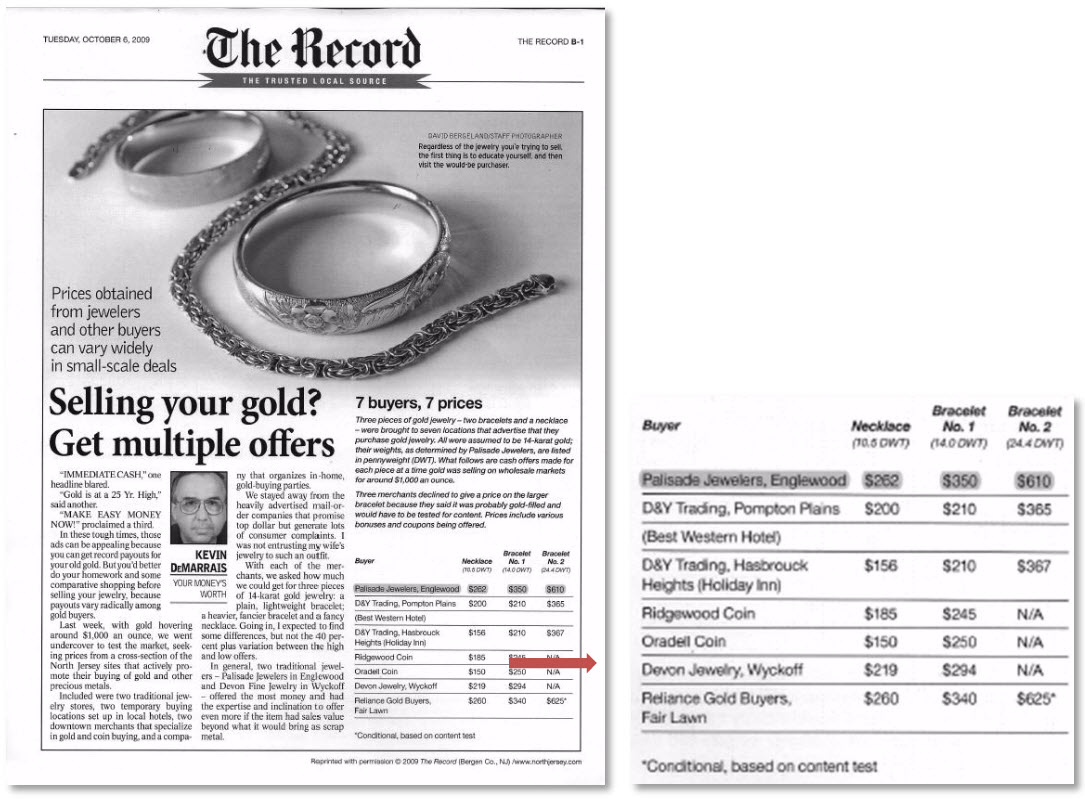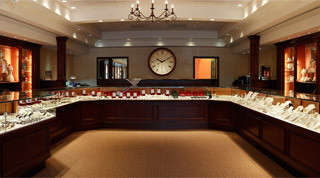As one of the world’s oldest forms of currency, gold and other precious metals can be a great source of ready cash. At Palisade Jewelers, we buy gold, silver and platinum jewelry in any amount. Here is some helpful information about how it works.
Why we’re the best place to sell gold
Even though the price of gold per ounce is set on the open market, it doesn’t mean you’ll get the same price wherever you go. In fact, where you sell your gold makes an enormous difference in the price you’ll be quoted. Remote or “mail-in” services require you to send your jewelry in for assessment, which means you do not know what day they are estimating your quote.
Because we’ve been in the business for almost 70 years, we have a reputation for fairness. When you walk in with gold or other jewelry to sell, we will weigh it, determine the karat, and give you a quote based on that day’s market price. If you like our offer, we’ll give you cash on the spot. Our immediate service protects you from price volatility.
The Bergen Record ran a side-by-side comparison of gold offers from a number of businesses in the area, and Palisade was the top offer.


Is your gold jewelry worth style or scrap?
Some jewelry is only worth the metal it’s made of. In the industry that’s known as gold’s ‘melt’ value, because we literally take it to a refiner to be re-melted. Could you go directly to a refiner? Only if you have several pounds of jewelry to sell for melt. Most refiners have minimum amounts they will deal with, so we buy gold and other precious metals to be refined in bulk.
Of course, if your jewelry has design value we’ll buy it to sell. We buy primarily Tiffany, Bulgari, Cartier or Van Cleef in modern jewelry, as well as vintage or heirloom pieces of any brand.
Understanding gold karats
The purity of gold is expressed in “karats,”(not to be confused with “carats,” which is the measurement of the weight of gemstones). Pure gold is 24 karats, but it is too soft for making jewelry, so it is usually mixed or ‘alloyed’ with other metals to help it hold its shape over time. Karat markings on gold jewelry indicate the percentage of pure gold. For instance, a 12K necklace is half gold, half other metals, because 12 is half of 24. 10K, 14K and 18K are the most common percentages in the US, but keep in mind if you’re selling your jewelry for its gold content, you will only be paid for the percentage of pure gold.
Sort your jewelry by karats
That’s why it’s important to sort your jewelry by gold percentage, or karats, beforehand. Some gold buyers will mix all your pieces together and give you a quote based on an ‘average’ of the different percentages. We don’t do that. We price each level of purity separately.
You can find the gold purity inscribed on every piece of jewelry made in the US, but these days it’s hard to know where a piece is made and it may not have clear markings. If you bring it in, we can assay it and tell you. To find the purity mark (called a ‘hallmark’), look on the clasp or other place that isn’t visible when the piece is worn. Rings are marked on the inside. Here are the most common markings:
Karat gold
22 karat (91.67% pure gold). Look for a mark of 22K or 22kt.
18 karat (75.00% pure gold). Look for an 18K or 18kt mark.
14 karat (58.53% pure gold). Look for 14K or 14kt.
10 karat (41.67% pure gold) Look for 10K or 10kt.
In the US, anything under 10 karats cannot be labeled gold.
Gold Filled vs Gold Plated
Gold is costly, so jewelry manufacturers have lots of ways to stretch the material while still giving a piece the look and appeal of gold.
Gold filling is a mechanical process where heat is used to bond a thin layer of gold to a baser metal - usually a brass alloy. To be called gold-filled, the gold has to make up at least 5% of the weight of the piece. You’ll see a mark “GF” or “14kt GF” if a piece is gold filled. Gold filling is thicker than gold-plating.
Gold-plated jewelry has been dipped in an electroplating bath and subjected to a current that bonds a very thin layer of gold to the underlying base metal. Gold plating is thinner than gold filling and can tarnish or wear off in spots. Look for a “GP” mark. Gold plated pieces are not usually accepted for melt purposes. There’s just not enough gold that can be recovered.
Vermeil
Vermeil usually refers to a layer of karat gold plated to sterling silver. To be considered vermeil the gold is required to be at least 10K and coated to at least 2.5 microns.
Color Gold
Gold alloys that produce color variations are always popular, although different colors come in and out of fashion. If you are selling color gold jewelry, keep in mind that the weight of the pure gold is what has value in the sale. Other metals in the alloy will be subtracted from the weight being purchased.
White gold is an alloy of gold and a white metal. 10% nickel to 90% gold is a common ratio that produces a hard, durable alloy good for rings and pieces that take a lot of wear. Palladium is used to whiten the gold appearance. Some pieces are rhodium-plated to appear white.
Rose gold is a gold and copper alloy. Various shades from pink to red are determined by the ratio of gold to copper. Silver and zinc may also be added to the alloy.
Silver and gold can produce Green Gold; Purple Gold is a brittle mix of gold and aluminum; Blue Gold contains either indium or gallium. Blue Gold is not to be confused with ‘bluing’ which is a heat treatment that turns steel components blue, often for use in fine watches.
Silver and Platinum
Sterling silver jewelry is marked 925, which means that 92.5% of the item’s total weight is fine silver. Sometimes you’ll see ‘ste’ or other hallmarks as well. Silver coins are 90% silver.
Platinum is very popular for wedding and engagement rings because it’s hypoallergenic. It’s a smart choice because wedding rings get constant wear (some brides make it a point of pride that they have never taken their wedding band off!) A platinum ring is made of at least 95% pure platinum. Look for the words platinum, or the abbreviation plat or pt. If it’s an alloy of less than 95% platinum, it will show the percentage as a multiple of 100 - 900 means 90%, 850 means 85%, etc.
Call us or contact us via email if you have questions about the value of your precious metal jewelry. We’re happy to help.


TESTIMONIAL
“My experience buying a pre-owned Rolex from Palisade Jewelers was perfect. I did the transaction by phone. The watch arrived, exactly as described; they gave me good, attentive service.”
- Richard
CALL OR COME
SEE US
Visit our store for a personal consultation with our watch and jewelry experts.



